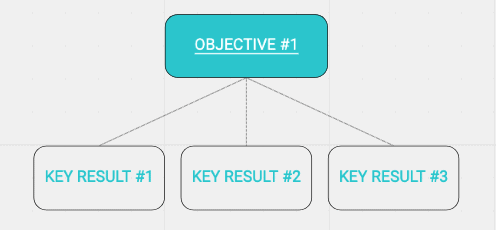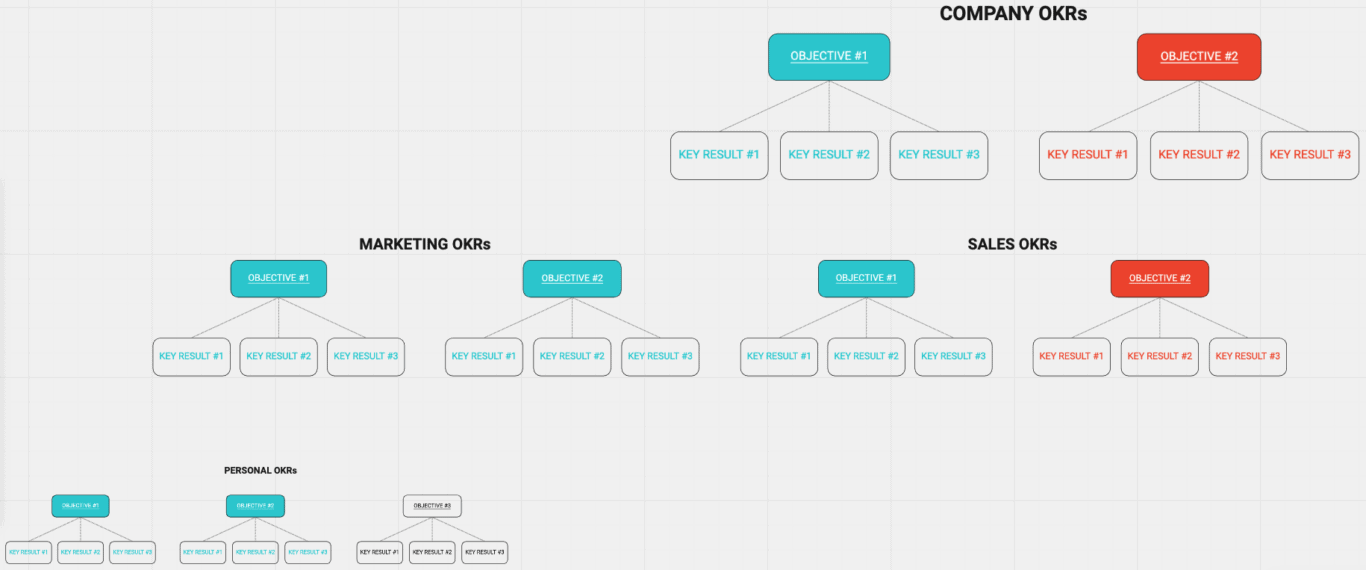OKR: How to Use Objectives and Key Results (With a Template + Examples)
Does your team understand your business goals? A recent Gartner survey found that less than half of employees understand the broad goals of their organization. Less than half! That’s like heading out for a road trip with two flat tires; you’re not going to get very far. If you want everyone on the team to know, understand, and be inspired by your business objectives, you might want to consider using OKRs.
The meaning of OKR
What does OKR stand for? If you took the time to read the headline, you already know the answer: objectives and key results.
That’s what it stands for, but what are they actually? OKRs are a popular approach to organizational goal-setting. Used by Google, among others, they allow you to build alignment around specific, trackable objectives and connect personal, team and company goals.
Basically, objectives are the high-level goals you want to achieve and key results are the metrics that allow you to measure that achievement.
Keep this in mind: OKRs represent what you want to achieve, but not how. In other words, don’t include the initiatives or tasks you’ll use to achieve your OKRs within the OKRs.
At Unito, we include initiatives as a layer beneath the objectives and key results. This allows us to clearly align our day-to-day work with the goals that we set.
OKR vs. KPI
A common question from people new to OKRs is, “How do they differ from KPIs?”
KPI, or key performance indicators, are simply the metrics you use to track the performance or health of a task or project.
OKRs, on the other hand, actually include the objective and metrics in a single package.
But the key distinction is really in the application. OKRs are meant for goal setting. The key results should be few in number and extremely targeted to those big objectives you set. KPIs, by contrast, can be any metric you use to track performance day-to-day. They could represent the number of likes on a Facebook post, your homepage bounce rate, or the clickthrough rate on a specific ad. You could track two or 20 of them. The focus and scale of OKRs is really what sets them apart.
When to use OKRs
Typically OKRs are set at the beginning of each quarter and last the duration of the quarter. This can vary by industry and company, however. If you think OKRs would be better suited to six months or one month, you can absolutely use them that way. The important thing is tracking progress throughout.
How to use OKRs
How to write effective objectives
Make them inspirational, but clear
Your objectives should build alignment across your team and organization. To achieve that, strive to make them inspirational. You need them to be something people want to rally behind. At the same time, they need to be clear, so anyone in the company will understand them. Balancing clarity and inspiration can be tough, but remember that your key results will bring additional clarity to your objectives.
What does this look like in practice? Instead of “Surpass our revenue target for the quarter by 10%” consider something like “Blow past our revenue target.” The KRs will show them what that means.
Brevity makes things memorable
If it takes more than a few seconds to read your OKRs, don’t expect your team to read them very often. You want people to have the OKRs in mind at all times, driving their priorities and decision-making. Writing long, drawn-out objectives makes them less interesting and less memorable. Keep things short and sweet.
Avoid metrics in your objectives
This seems simple, since key results are a natural home for metrics. But a lot of people struggle to write objectives that aren’t framed using the metrics. The instinct is to always include “by how much” at the end of an ambitious goal. Fight that instinct, keep your objectives concise, and leave the metrics to the KRs.
One good trick is to focus on the “why?” If you’re thinking “we need to increase metric X by Y,” ask yourself why. You’re not in the business of making numbers go higher. There’s a purpose behind those metrics, and that should be the focus of your objectives.
Get input from stakeholders
Only three percent of organizations involve peers in the goal-setting process. Think about all of the insight you’re missing out on!
The easiest way to get buy-in on your OKRs is to ask for input as you craft them — both on the substance and on how they’re written. This applies whether you’re at the top of the organization and want your reports to be inspired by your objectives, or you’re somewhere in the middle and need approval on your direction from your manager.
Pro tip: Encourage stakeholders to give you feedback
A project’s stakeholders are usually some of the busiest people in the organization. It’s one thing to know you want their feedback, it’s another to actually get them. When trying to get that feedback, you have to go out of your way to make it as simple and straightforward as possible; you also have to set expectations from the get-go. You also want to be sure you’re making the most out of that feedback.
Here’s how
How to write effective key results
Make them high-impact
Crafting a key result isn’t just about finding a good number and calling it a day. An ideal key result is directly related to your objective and communicates the impact it will have on the company at large. When adding key results to your OKR, you should try and shoot for big, impressive numbers. Something achievable, but just out of your reach.
At Unito, we differentiate between two kinds of key results: moonshots and targets. A moonshot is something you know is out of your reach, so much so that you’d be satisfied if you hit 75% of the metric. Conversely, a target is a more achievable number, one you’d be disappointed if you didn’t hit. Not all key results need to be moonshots, but they should all be ambitious.
Keep them specific
Your key results should be as specific as possible. If you were building OKRs for a whole company or a department, you could still get value out of a vague key result — since it needs to represent broader contributions. But when you’re drafting personal OKRs, you want specificity. Key results show the direct impact your objectives will have on the business.
It’s not enough to say “I’m going to provide better customer service.” Your key result should be something like “average ticket response time reduced by 50%.” That shows how completing your objective will make things better for the whole team.
Go for influence rather than control
If you’re writing your first OKRs, your instinct might be to make the key results something that you can control. Say your objective is creating better paid ads for a future marketing campaign. You might think a good key result is something like “create 15 new ads,” since that’s a number you can control. But key results aren’t about tracking your direct effort. Rather, they’re meant to track the impacts of your effort. If you want to set a goal like that for yourself, that’s great! Just be aware that it’s not really the purpose of the OKR process.
OKR examples
Let’s imagine a gaming software company launching a brand new product this quarter.
On the organizational level, this major product launch needs to be captured in an OKR. That might look something like the following:
Company objective: Product X Makes Waves in the Gaming Industry
- KR 1: 1,000 downloads of Product X by August 1
- KR 2: 12% YoY increase in company MRR in July
- KR 3: 100,000 Product X landing page visits
The marketing department will also want to have an OKR aligned with the company objectives and metrics.
Marketing objective: Create massive pre-launch buzz around Product X
- KR 1: 500 waiting list sign-ups ahead of July 10 launch
- KR 2: 10,000 waiting list landing page visits
- KR 3: 200% YoY increase in incoming media requests for July
Finally, an individual member of the marketing team, say a paid advertising specialist, might have a personal goal that aligns with this specific launch.
Personal objective: Create killer ad campaigns for Product X
- KR 1: 150 waiting list sign-ups attributed to paid campaigns
- KR 2: 5,000 waiting list landing page visits attributed to paid campaigns
- KR 3: 5% increase in display ad click-through rate MoM for July
OKR template
Want to apply the OKR framework within your business? We’ve put together a handy template that you can use with your team. You can access the Google Doc at the link below, and either copy it or download it.
The value of OKRs
OKRs help you focus on the big rocks
There’s an oft-used metaphor in business circles that compares tasks to rocks in a jar. The big rocks are your most important tasks and the little rocks are smaller or less valuable tasks. If you fill your jar with small rocks, you’ll have much less room for the big stuff. But if you start with the big rocks, small rocks can also filter through.
This is a roundabout way of saying that it’s important for us to focus on the largest, most valuable work first. The smaller stuff will still filter through the cracks, and you’ll have the opportunity to tackle these tasks with the leftover space in your schedule (or jar!). OKRs emphasize the big rocks, helping everyone prioritize the most important work.
OKRs keep everyone aligned
For your business to succeed, you need everyone moving in the same direction. OKRs are like a waypoint, guiding the way.
By setting company-wide OKRs, every single member of the team knows what the end goal is and how you plan to get there. Everyone is on the same page. This means easier collaboration and built-in agreement on priorities and outcomes.
OKRs accelerate decision-making
When your teams and individual contributors know what work to focus on, they can make decisions quickly and independently.
The goals and priorities are transparent — they’re laid out in the OKRs for everyone in the company to see. That information acts as a primary reference point, so you don’t need to run every decision or conflict up the chain.
If you set broad objectives, and agree on what achievement looks like, you can then leverage the expertise of all of your staff and empower them to decide how you get there.
OKRs measure progress
The entire point of goal setting is to actually move the business forward. The key results that make up half of OKRs are your measuring stick.
Once you set your OKRs, you can check-in regularly to see how things are progressing. If you’re not approaching your key results, you know to raise the red flag. This allows you to act quickly and eliminate blockers. Sometimes, you also realize that the initiatives are not optimal to reach your results. Or even that your key results might not actually get you to the objective. It’s ok to change things so long as you keep the objective in mind and everyone is aligned.
Then, at the end of your quarter or designated OKR period, you can look back at your achievements against the OKRs and learn from your mistakes and successes.
OKRs create a culture of ambition
Of course, not actually hitting your key result doesn’t necessarily mean you’ve failed. Unlike traditional goal-setting, OKRs emphasize effort and progress.
OKRs are about setting ambitious goals, and will likely be a mixture of essential/attainable results and aggressive results — what we call “moonshots” at Unito. The moonshots are goals that we would love to achieve, but won’t be easy to complete by any means. That doesn’t make the process of working on them any less valuable to the business.
Setting moonshots encourages your team to really set the bar high (or reach for the stars, to stick with the metaphor). And by not focusing so much on completion (or punishment for lack of completion), nobody sacrifices quality in order to hit their goal. People should be encouraged to maintain high standards of work even if it slows progress on KRs.
The OKR framework
When creating an OKR, start with a single objective. It should be simple, inspiring, easy to remember, and measurable. And remember, be ambitious.
Once you’ve established your objective, you now need two to three key results. You should be able to track these using a completion percentage (i.e. “We hit 98% of our key result. So close!”). This allows you to track progress throughout the entire period that the OKR is applicable.
A single OKR will look something like this:

OKRs start at the company level, then trickle down to the department and individual levels. This ensures that every team and every person is working towards the same goals.
As a rule of thumb, you also want two to three key objectives at each level. Once completed, your OKRs will look something like the following.

When crafting OKRs, departments and individuals should first look at the higher-level OKRs for guidance. This creates a cascading interplay of objectives that keep the entire company aligned.
Company OKRs
- Set by the CEO/executive team
- Capture the most important business objectives
Department/team OKRs
- Set by department heads in collaboration with team leads/executive team
- Capture the most important ways the department can contribute to the company OKRs
- Should complement the OKRs of other departments for horizontal alignment
Personal OKRs
- Set by individuals in collaboration with their managers
- Capture the most important ways they can contribute to the departmental goals
- Should complement the OKRs of their teammates for horizontal alignment
- Personal OKRs may sometimes also capture personal development goals
As mentioned above, once the OKR crafting is complete, we’ll then work within our teams to come up with the initiatives that will allow us to achieve those goals. We layer those beneath each key result, so our activities are clearly aligned to our goals.
How to track OKRs
Tracking of OKRs should be done at regular intervals, not only at the end of your quarter. The idea is to track progress so you can raise flags about blockers, bandwidth or resource issues, or whatever else is standing in the way of that objective. Since OKRs scale up from the individual to the company levels, regular monitoring allows you to flag individual or team issues that could have company-wide impact.
At Unito, we check in on our OKRs on a weekly basis in team meetings. We update completion percentages and add an emoji to capture our confidence in each objective.
- OKRs that will definitely be completed get a green apple.
- OKRs that are at risk get a yellow banana.
- OKRs that will not be completed get a red tomato.
Then, at the end of the quarter or the OKR cycle, we review our OKRs and set a final completion percentage. On a company and departmental level, we’ll typically hold retrospectives with key stakeholders to look back on the objectives, analyze our performance, and put together a start/stop/continue list with our learnings. For personal OKRs, managers have a 1on1 with their reports to review results, share feedback, and collaborate on key learnings.
OKR software
So how do you actually keep track of your OKRs? They could live in a document or even on an office wall if you want them to. But if your goal is to make them prominent and accessible by everyone in the company, you may want to look at your project management tools.
At Unito, we keep our OKRs organized in Asana. We have projects for company OKRs, departmental OKRs, and personal OKRs. Each OKR is a task, within which key results are listed as subtasks. In addition to the typical task fields (title, assignee, due date, etc), we’ve also created a field to track progress by percentage and another for the emojis mentioned above.
Then, we use Unito to sync these tasks and projects to other tools used by our teams, like Trello and GitHub. This ensures the most important objectives in our business are visible no matter where the team is working.
Of course, there is also OKR-specific software you can explore if you’re looking for a catered solution. This includes:
R you OK with goal-setting?
Many organizations struggle with goal-setting. Some managers spend more time creating their objectives than they do actually working on them. Don’t fall into that trap.
With effective OKRs, you can create the organizational alignment you’re after — all while inspiring your team and helping to make sure everyone’s priorities are in order.
How Unito helps you hit your OKRs
With Unito, you can automate reporting and streamline workflows, saving time as you work towards your objectives.

